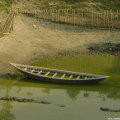
Mismatched researcher and practitioner goals may limit the production of useful knowledge to measurably improve flood risk management practices. What steps can we take to improve communication and goal alignment?
Scientists study floods to better predict the probability and timing of flood events that may have disastrous consequences to human life, ecosystems, and property. Flood management professionals, both in the private and public sector, work to mitigate and prevent damage from flood events through risk management. Researchers from NCAR and the University of Colorado conducted interviews and less structured discussions with government employees, private sector consultants, and researchers in order to determine what types of new information could be developed by researchers that would be helpful to practitioners who must manage flood risks through policy recommendations, regulation enforcement, and infrastructure construction and management.
Findings and Impacts
While researchers may believe that improving the quality or availability of scientific information to decision makers is useful, the practitioners who estimate and manage flood risk consider scientific evidence for their decisions, but must also operate under other constraints — such as regulatory, institutional, or resource limitations. These constraints can add more uncertainty and complexity to their decisions. While scientists conceptualize decision-makers as the end-user of information characterizing scientific uncertainty in flood risk estimation, in reality, the practitioners responsible for flood risk management decisions may prioritize other concerns and require different input from scientists. For example: practitioners are concerned with the cost-effectiveness of measures and must evaluate the usefulness of information based upon the impact it may have on the decision-making process and outcomes. Adding an additional safety margin around a flood prone area may not be a precise scientific approach to dealing with flood-risk uncertainty, but it is simple and cost-effective for protecting lives and property. However, better quantification and analysis of the uncertainty surrounding flood risk may come at significant cost and may not provide better guidance for policy measures.

These box culverts are designed to channel flood water away from buildings and toward the Napa River (California, U.S.), and they were constructed as part of the Napa Creek Project, a joint effort between the City of Napa, the Napa Water Flood Control and Conservation District and the U.S Army Corps of Engineers. Photo credit: Tyler Stalker for USACE Sacramento via Flickr.
Implications and Further Reading
Many people have noted that successful relationships between science and decision-making requires connecting decision makers to the research-development process. This necessitates long-term partnerships among scientists, product developers, and decision makers. This so-called “end-to-end-to-end” approach recognizes that information use and adaptation to processes or tools changes when we introduce new information or tools to the parties involved. When research only addresses the scientific aspects of a system, rather than the natural and societal components together, the work often fails to achieve the desired results. For science to have a positive impact on problems that have both natural and societal components, relationship-building and cross-disciplinary understanding is required. This process could involve multiple iterations over months or even years depending on the scale and environment for the topics and policy decisions. While this study focused on flood risk management, this applies to other topics as well. For example: climate change science has similar mismatches between research to better address scientific uncertainty and the practical decision-making implications for adaptation and mitigation.
This is a short summary of a 2005 BAMS article by Rebecca E. Morss et al, Flood Risk, Uncertainty, and Scientific Information for Decision Making: Lessons from an Interdisciplinary Project. Please read the original article for more in-depth discussion and two brief case study examples. We would additionally suggest Morss et al, Improving Societal Outcomes of Extreme Weather in a Changing Climate: An Integrated Perspective in the Annual Review of Environment and Resources (v.36, pp.1-25) for an overview of societal vulnerability and adaptive capacity related to extreme weather events, as well as an initial examination of opportunities for scientists and practitioners to co-address knowledge gaps.




